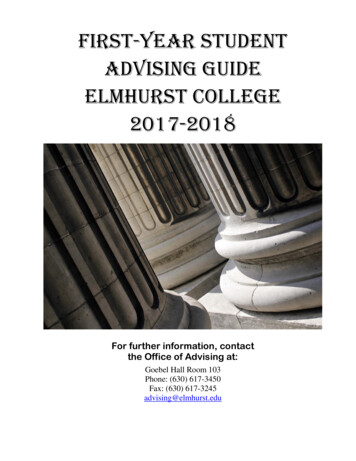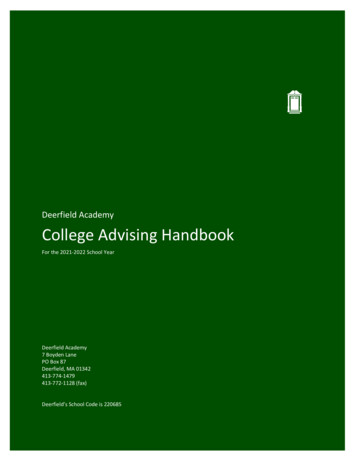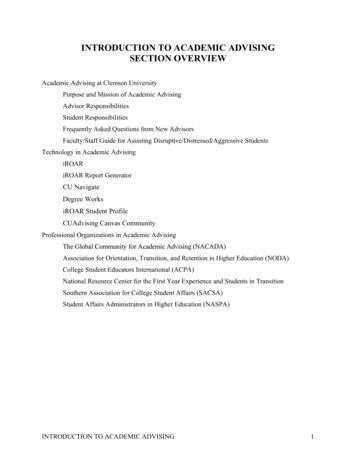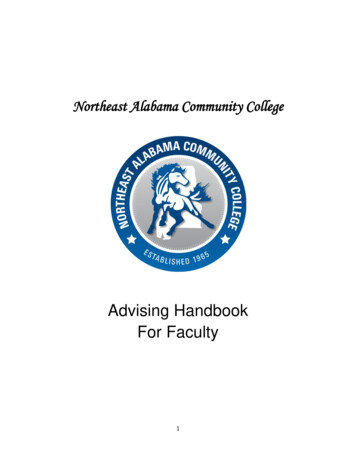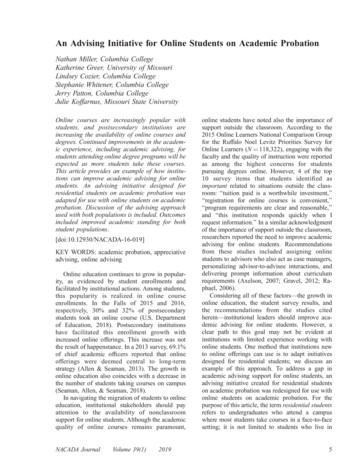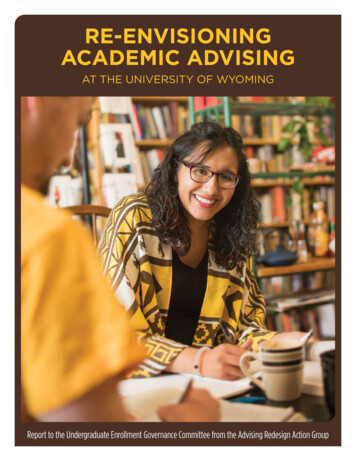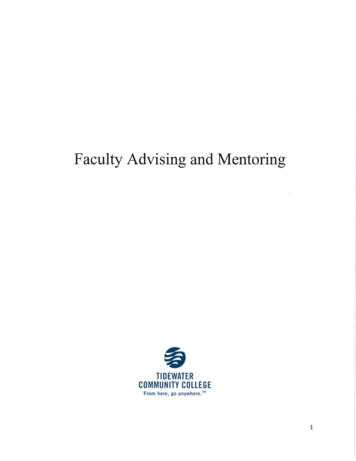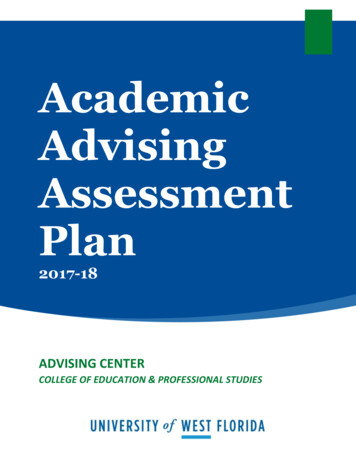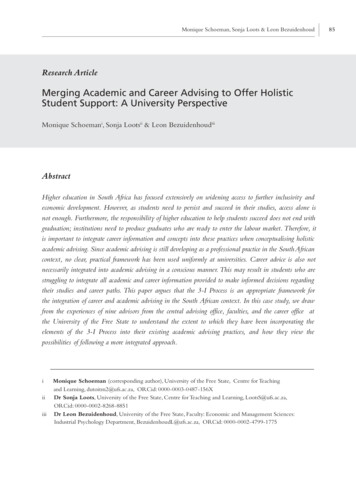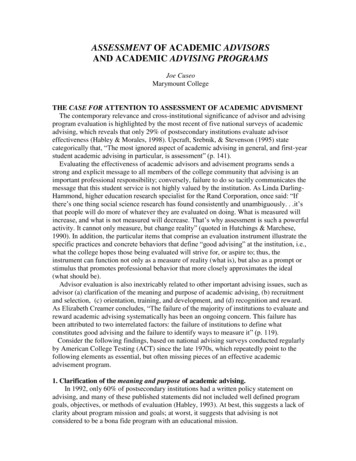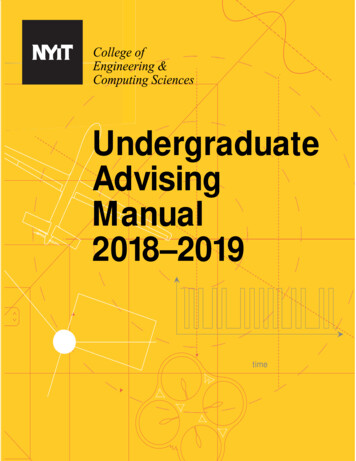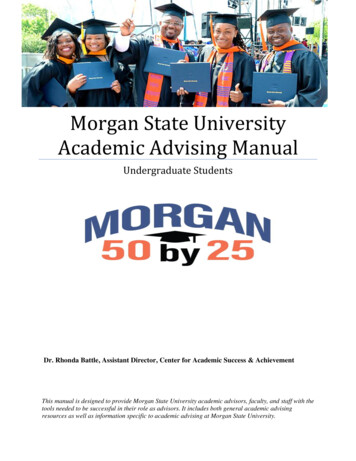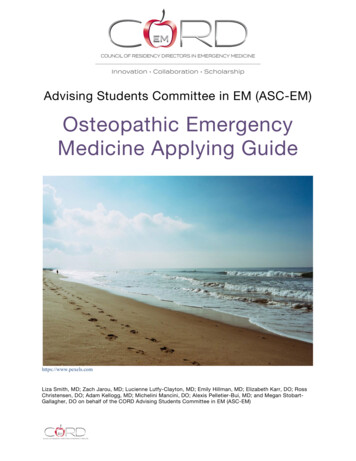
Transcription
Advising Students Committee in EM (ASC-EM)Osteopathic EmergencyMedicine Applying Guidehttps://www.pexels.comLiza Smith, MD; Zach Jarou, MD; Lucienne Lutfy-Clayton, MD; Emily Hillman, MD; Elizabeth Karr, DO; RossChristensen, DO; Adam Kellogg, MD; Michelini Mancini, DO; Alexis Pelletier-Bui, MD; and Megan StobartGallagher, DO on behalf of the CORD Advising Students Committee in EM (ASC-EM)
This applying guide is intended for the osteopathic medical student seeking topursue a successful match in the ACGME system.Background & OverviewHistorically, there have been two paths for the osteopathic student (DO) pursuingemergency medicine (EM)—applying to osteopathic-affiliated residency programsunder the American Osteopathic Association (AOA) or to allopathic-affiliated residencyprograms under the Accreditation Council for Graduate Medical Education (ACGME),otherwise known as the National Resident Matching Program (NRMP).In February 2014, the ACGME, AOA, and American Association of Colleges ofOsteopathic Medicine (AACOM) announced a path toward formation of a singlegraduate medical education accreditation system. Under this plan, AOA-approvedprograms can apply for ACGME accreditation by June 2020, when the AOA will ceaseall primary accreditation activities and all EM training programs will be under theACGME umbrella.Starting with 2017-18 match season, many osteopathic programs had alreadyconverted to their initial ACGME accreditation. A program director survey from 2016reported that 19 of the transitioning AOA programs reported they would be pursuingadditional “Osteopathic Recognition” by 2020 in which programs maintain anosteopathic-focused learning environment. This may include, but not be limited to,integrated osteopathic principles into clinical rounds, dedicated osteopathicmanipulation conference, and dedicated rotations focusing on core osteopathicprinciples. Allopathic graduates can be accepted into these programs, but there maybe some pre-matriculation requirements, yet to be determined. At the time ofpublication of this guide, only three ACGME accredited programs have obtainedOsteopathic Recognition. More information regarding Osteopathic Recognition and itsrequirements for programs can be found on the ACGME website.Why have osteopathic students historically wanted to apply to ACGME programs?The reasons given during the last several years by rotating students and residents whograduated from osteopathic schools: The opportunity to train in larger medical centersOption for three-year training programsAcademic affiliations of the training programsLarger programs and the stability that comes with themGreater perceived opportunities for fellowshipsMore programs to choose fromAvoid uncertainty with the current transition to ACGME accreditation for AOAprograms Ability to obtain EM board certification with either ABEM or AOBEM
What are the chances?In the 2018 match, there were 2,278 EM spots available with 70.5 percent filled byallopathic graduates. Approximately 13 percent of ACGME EM slots went toosteopathic students (Table 1).1Table 1: Percentage of Osteopathic Students Matching in Emergency Medicine1Despite the competitive nature of applying to ACGME residency programs as anosteopathic medical student, the number of osteopathic graduates matching inemergency medicine through the NRMP Match has been very stable over time andover the last two years has actually been increasing, likely reflecting the transition ofAOA programs to ACGME accreditation (Figure 1).1Figure 1. Percentages of NRMP Matches by Applicant Type 2009-20181What are the obstacles in applying?To maximize your chances of a successful match, it is imperative to have a strongapplication. A big obstacle to an osteopathic student’s application to the ACGMEsystem is perceived competitiveness. The issue of bias against DO students in the
selection process is very real. In the 2018 NRMP Program Director’s (PD) survey, only81 percent of traditionally allopathic programs responded that they would interviewand rank DO students, narrowing the number of programs available to apply to overall(Figure 2).2 There is no ‘official list’ of programs who have historically been less opento DO applicants, so it will take some legwork in order to best create your applicationlist (see below for more information).Figure 2. Percentage of Programs that Typically Interview and Rank Each Applicant Type2A successful match will require planning in order to have taken the USMLE and havetwo EM rotations scheduled early in the fourth year, preferably before October, in orderto have Standard Letters of Evaluation (SLOEs) submitted to the Electronic ResidentApplication Service (ERAS) as soon as possible. Emergency Medicine Residents’Association (EMRA) Match for Clerkships shows that 95 percent of clerkships (n 123)will accept DO students, and of the 83 percent of clerkships that require USMLE orCOMLEX scores before rotations, there is a preference for USMLE over COMLEX.EMRA Clerkships is an excellent resource to help you research rotations and identifythose that accept DO students.Maximizing Your Application*Check out the Osteopathic Medical Student Planner for specific recommendations byyear of your medical school training.*To even the playing field, you need to make yourself as competitive as possible toallow programs to compare you with your allopathic peers. It is also important to avoidany red flags on your application that would diminish your chances of matching. Theseinclude: failing classes, failing or scoring low on COMLEX or USMLE examinations,felonies, professionalism issues, and unexplained gaps in training. If you do have anyof these red flags, it will make it very difficult for you to match in EM. Please refer to the
At-risk Applicant Applying Guide for additional information and ways to address theseissues.If possible, make sure to be actively involved in your school’s Emergency MedicineInterest Group (EMIG) and find a mentor. A good mentor can be critical. Find an EMfaculty advisor who is involved with an ACGME residency. These faculty are the mostfamiliar with the application process and will be able to give the highest quality advice.They can give you feedback on your application and help you figure out how manyplaces to apply as well as guidance about where to apply. Identifying a mentor may bechallenging as an osteopathic applicant. A recent study of current EM residentsshowed that while 70 percent of allopathic institutions have designated EM facultymentors, only 20 percent of osteopathic institutions offered EM faculty mentors to theirstudents.3If your school isn’t affiliated with a training program or if it lacks EM faculty foradvisement, consider joining EMRA, SAEM, or other professional organizations.Through EMRA’s Medical Student Council, you can be paired with a resident mentor.Students can also participate in large-group virtual advising sessions through EMRAHangouts. Other options for EM application and career guidance include: Get involved with your school's chapter of American College of OsteopathicEmergency Physicians (ACOEP) student section and/or the ACOEP ResidentStudent Organization (RSO). They also offer a mentoring program, regionalsymposiums, and numerous residency fairs at national meetings. Attend a regional or national EM conference; many have advising forums and/orthe opportunity to network with program faculty. American College ofEmergency Physicians (ACEP) in the Fall and Society for Academic EmergencyMedicine (SAEM) in the Spring both offer residency fairs. Ask your upperclassmen how/when/where they found a mentor. Also, querytheir personal experiences and listen to their recommendations. Someone whohas just completed the process can have invaluable information. Reach out to a program you’re interested in to see if they have faculty who willadvise you. Faculty mentors are often available during your out-of-townrotations; consider asking one of their residency leaders for advising.In planning to maximize your EM application, the three areas that are most critical areboard scores, EM rotation performance, and standardized letters of evaluation(SLOEs):1. Board Scores: For starters, the average COMLEX scores of DOs who matchinto ACGME EM programs are 569 and 621, for level 1 and level 2 respectively.4Some ACGME residency directors may be unwilling to accept only a COMLEXscore or will look for a grossly higher COMLEX score than the equivalentUSMLE score. These tests allow your knowledge base to be compared directlyto your MD peers; there is no accurate conversion to translate a COMLEX score
to a USMLE score although the NBOME does offer a percentile score calculatorfor converting the three-digit COMLEX step score to a percentile.5-7 A recentsurvey of program leadership administered by CORD’s Advising StudentsCommittee in EM (ASC-EM) showed that of programs who consider osteopathicapplicants, only half of them would extend an interview to an applicant who hadnot taken either step of the USMLE. This number jumped to 87 percent whenthe osteopathic applicant had taken USMLE Step 1. The same ASC-EM surveyshowed that 90.3 percent of program leadership surveyed (N 104) will considerosteopathic applications. But when it comes to boards, when a candidatesubmitted both USMLE and COMLEX scores, only 15 percent (n 88) heavilyweighted the COMLEX, while 26 percent gave it a slight weight, 27 percent didnot weigh it at all, and 31 percent would only weigh the COMLEX score if it waslisted as a failure.8 Acceptance of COMLEX scores may change as the applicantpool expands at historical ACGME programs and programs become morecomfortable with interpreting the COMLEX, but we have some time before thatbecomes the norm.Therefore, we recommend you take the USMLE (Step 1 and Step 2 CK) inaddition to the required COMLEX; students who do so are more likely to match.7If you are only able to take one of the two USMLE exams, taking Step 1 will giveyou better access to clerkship rotations and, by extension, SLOEs.8 It will alsoincrease your chances of being considered for an interview at residencyprograms who consider DO applications.As an osteopathic medical student, you are required to take COMLEX Level 1,2CE/PE, and Level 3 for licensure. The USMLE will not assist you with licensure;it merely will serve as a tool for program directors to compare you. If taking theUSMLE, you will not be required to complete all of the steps, but you can takethem independent of one another (i.e. can take Step 1 without 2, and viceversa).While the USMLE and COMLEX exams are similar, it is imperative that you studyspecifically for the USMLE and are scoring above the national average onpractice exams before actually sitting for the exam to maximize your score. Agood score will increase your chances of matching.USMLE Step 1 scores around 225 or greater and USMLE Step 2 scores around240 or greater will help you get interviews.2 USMLE Step 1 scores less than 210and USMLE Step 2 scores less than 220 may make it much more difficult foryou to get interviews (Figure 3).2 If possible, try to take USMLE Step 2CK early infourth year so you can have your scores released by Oct. 1, especially if yourStep 1 score is 220. For USMLE Step 1 scores 220, a backup plan is stronglyadvised.
Figure 3. Average USMLE Step 1 and Step 2CK Scores Programs Consider When GrantingInterviews.22. Rotations: You will need to try to secure at least two EM audition electives,ideally at academic programs with an ACGME residency program. You will wantto rotate as early as possible in your fourth year in order to have at least oneStandard Letter of Evaluation (SLOE) available when the Electronic ResidencyApplication Service (ERAS) opens in mid-September. You will be side by sidewith your allopathic peers on these rotations and will demonstrate yourperformance in an academic setting similar to the residencies to which you willbe applying.Note that many academic programs use the Visiting Student LearningOpportunities Service (VSLO) for audition rotations and start acceptingapplications as early as February or March. Keep your eye out for any programspecific dates and application requirements. For example, programs mayrequire a USMLE Step 1 score, a CV, or a brief personal statement. Programsmay use audition rotations as a recruitment tool as much as you will use it toexplore the program.You can utilize EMRA Clerkships as a resource to find programs that willinglyaccept DO students into their clerkships.3. Letters of Recommendation: The letters of recommendation that carry themost weight will be in the SLOE (Standardized Letter of Evaluation) format andcome from residency program leadership. You should aim to get two SLOEsfrom academic residencies, preferably group SLOEs written by the educationalteams where you rotate. The recent CORD ASC-EM PD survey showed that79.1 percent of program leadership recommend two SLOEs for osteopathicapplicants.8 These letters carry more weight than traditional letters of
recommendation because they provide context for direct comparison of you toyour EM-bound peers by people integral to the EM match process. Thesestandard letters are one of the most frequent omissions from osteopathicapplications and one the most highly-valued aspects of the EM applicationprocess to PDs,2 making it difficult to accurately compare osteopathicapplicants to the rest of the applicant pool.While community EM months can be great learning experiences and expose youto how the majority of EM physicians practice, they will not significantly assistyour application to an ACGME EM residency. A letter of recommendation oreven an SLOE written by a doctor at a community ED is not the same thing asone from an ACGME program and may not be counted as equivalent. If yourschool requires a community EM experience, you will have to do extraclerkships in EM, and in some instances, even forgo credit to gain opportunityand advancement in your application.How many programs should I apply to?Depending on the strength of your overall application (USMLE scores, EM clerkshipperformance, SLOEs, etc.), consensus from the recent ASC-EM survey is that thetypical DO applicant should consider applying to somewhere between 31-40 realisticprograms in order to obtain approximately 12 interviews to have a strong chance of asuccessful match.8 This number may also need to take into account region of thecountry and your overall competitiveness.The “numbers question” truly requires an individualized answer from an advisor familiarwith the EM application process who can help you assess how competitive anapplicant you are. For a less competitive applicant, it is important to have a frankdiscussion about a parallel application plan in case the EM interviews are notforthcoming.Data show that applicants who ranked nine programs had an approximately 90 percentmatch rate in EM. Those with 11 or more programs pushed that match rate up to 95-99percent (Figure 4).4Figure 4. Probability of U.S. Osteopathic Medical Students/Graduates Matching to PreferredSpecialty by Number of Contiguous Ranks4
Which programs should I apply to?One common strategy to identify programs accepting DO applicants is to look at thecomposition of the current residency classes at an institution—if they have DOs,especially if they have matched someone from your school, they will likely consideryour application. If they have no DOs, you need to be realistic about the likelihood ofan interview; however, it is still worth the application if you truly are interested in theprogram. In this instance, you may not want to count this program in the overallnumber of places where you are applying. In other words, apply to 31-40 programsthat you think you have a high likelihood of getting into and that commonly accept DOstudents. Once again, reach out to an advisor if you are unsure about yourcompetitiveness, if you think there might be red flags in your application, or if you haveboard scores that may make you less competitive.Osteopathic students may benefit from focusing on geographical areas which havehistorically matched higher percentages of osteopathic applicants. Between the years2012-16, Indiana, Iowa, Mississippi, Ohio, and Texas matched the most osteopathicstudents per ACGME residency program per year (Figure 5).9Figure 5. A Geographical Representation of Average Number of Osteopathic ResidentsPer Program Per Year9
In terms of raw numbers, on average over the past five years, New York, Pennsylvania,Texas, Ohio, and Michigan have accepted the most osteopathic students into ACGMEprograms each year (Table 2).9Table 2. Average Number of DO Residents in ACGME Programs by StateState20122013 2014 2015 2016AverageNumber of DOResidentsMatched intoACGMEProgramsNumber ofACGMEPrograms (as of2015)New 5191915.411Illinois1113991711.88New 6.65Massachusetts459766.25EMRA Match can be used to sort programs by the percentage of DO residents intraining at individual locations. Be aware that just because a program has few or noDOs does not mean they are closed to receiving your application.
Some programs who give consideration to both types of students may rankacademically equal MDs above DOs. Not surprisingly, to be successful in matching,you need to stand out as a candidate and be strategic in planning your application.What are some tools and resources that can help me?There are a lot of great resources out there. Here are a few of the high-quality ones: EMRA MatchEMRA ClerkshipsCDEM CurriculumEMRA HangoutsKey Points1. Taking the USMLE Step 1 and Step 2 will allow your knowledge base to becompared with your allopathic peers and increase your chances of getting bothaudition rotations and residency interviews. A USMLE Step 1 score 220warrants taking Step 2 CK early as well as considering a backup plan.2. Try to complete two audition elective rotations at ACGME residency-basedtraining programs before October of your fourth year.3. Aim to get two Standard Letter of Evaluations (SLOEs) from ACGME EMprograms submitted as early as possible, with at least one uploaded by the timeERAS opens on Sept. 15.4. Be strategic with your application and use your resources. Do some legwork toidentify programs that are open to interviewing and matching osteopathiccandidates.5. Find an advisor early who is familiar with the EM application process to discussyour application, help gauge your competitiveness, and come up with a backupplan if needed.References1. National Resident Matching Program, Results and Data: 2018 Main Residency Match.National Resident Matching Program, Washington, DC. 2018.2. National Resident Matching Program, Data Release and Research Committee: Resultsof the 2018 NRMP Program Director Survey. National Resident Matching Program,Washington, DC. 2016.3. Stobart M, O'Connell A. Medical Education Accreditation System: Evaluating Factorsfor Match Success in Emergency Medicine. Western Journal of Emergency Medicine:Integrating Emergency Care with Population Health. 2018. (Accessed August 1 2018 athttps://escholarship.org/uc/item/9cc5n91z).
4. National Resident Matching Program, Charting Outcomes in the Match for U.S.Osteopathic Medical Students and Graduates. National Resident Matching Program,Washington, DC. 2018.5. Sarko J, Svoren E, Katz E. COMLEX‐1 and USMLE‐1 Are Not InterchangeableExaminations. Academic Emergency Medicine. 2010; 17:1–3.6. Lee AS, Chang L, Feng E, Helf S. Reliability and Validity of Conversion FormulasBetween Comprehensive Osteopathic Medical Licensing Examination of the UnitedStates Level 1 and United States Medical Licensing Examination Step 1. Journal ofGraduate Medical Education. 2014, 6(2): 280-283.7. Weizberg M, Kass D, Husain A, Cohen J, Hahn B. Should Osteopathic StudentsApplying to Allopathic Emergency Medicine Programs Take the USMLE Exam? West JEmerg Med. 2014 Feb; 15(1): 101–106.8. Council of Emergency Medicine Residency Directors Advising Students Committee inEmergency Medicine. (2018). [CORD ASC-EM Advising Addenda Study]. Unpublishedraw data.9. National Resident Matching Program, Main Residency Match: Match Rates by Specialtyand State, 2012-2016. National Resident Matching Program, Washington, DC. 20122016.
Historically, there have been two paths for the osteopathic student (DO) pursuing emergency medicine (EM)—applying to osteopathic-affiliated residency programs under the American Osteopathic Association (AOA) or to allopathic-affiliated residency programs under the Accreditation Council for Graduate Medical Education (ACGME),
